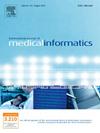An interpretable hybrid machine learning approach for predicting three-month unfavorable outcomes in patients with acute ischemic stroke
IF 3.7
2区 医学
Q2 COMPUTER SCIENCE, INFORMATION SYSTEMS
International Journal of Medical Informatics
Pub Date : 2025-01-22
DOI:10.1016/j.ijmedinf.2025.105807
引用次数: 0
Abstract
Background
Acute ischemic stroke (AIS) is a clinical disorder caused by nontraumatic cerebrovascular disease with a high incidence, mortality, and disability rate. Most stroke survivors are left with speech and physical impairments, and emotional problems. Despite technological advances and improved treatment options, death and disability after stroke remain a major problem. Our research aims to develop interpretable hybrid machine learning (ML) models to accurately predict three-month unfavorable outcomes in patients with AIS.
Methods
Within the framework of this analysis, the model was trained using data from 731 cases in the dataset and subsequently validated using data from both internal and external validation datasets. A total of 25 models (including ML and deep learning models) were initially employed, along with 14 evaluation metrics, and the results were subjected to cluster analysis to objectively validate the model’s effectiveness and assess the similarity of evaluation metrics. For the final model evaluation, 10 metrics selected after metric screening and calibration analysis were utilized to evaluate model performance, while clinical decision analysis, cost curve analysis, and model fairness analysis were applied to assess the clinical applicability of the model. Nested cross-validation and optimal hyperparameter search were employed to determine the best hyperparameter for the ML models. The SHAP diagram is utilized to provide further visual explanations regarding the importance of features and their interaction effects, ultimately leading to the establishment of a practical AIS three-month prognostic prediction platform.
Results
The frequencies of unfavorable outcomes in the internal dataset and external validation dataset were 389 / 1045 (37.2 %) and 161 / 411 (39.2 %), respectively. Through cluster analysis of the results of 14 evaluation metrics across 25 models and a comparison of clinical applicability, 12 ML models were ultimately selected for further analysis. The findings revealed that XGBoost and CatBoost performed the best. Further ensemble modeling of these two models and adjustment of decision thresholds using cost curves resulted in the final model performing as follows on the internal validation set: PRAUC of 0.856 (0.801, 0.902), ROCAUC of 0.856 (0.801, 0.901), specificity of 0.879 (0.797, 0.953), balanced accuracy of 0.840 (0.763, 0.912) and MCC of 0.678 (0.591, 0.760). Similarly, the model exhibited excellent performance on the external validation set, with a PRAUC of 0.823 (0.775, 0.872), ROCAUC of 0.842 (0.801, 0.890), specificity of 0.888 (0.822, 0.920), balanced accuracy of 0.814 (0.751, 0.869) and MCC of 0.639 (0.546, 0.721). In terms of the important features of AIS three-month outcomes, albumin ranked highest, followed by FBG, BMI, Scr, WBC, and age, while gender exhibited significant interactions with other indicators. Ultimately, based on the final ensemble model and optimal decision thresholds, a tailored short-term prognostic prediction platform for AIS patients was developed.
Conclusions
We constructed an interpretable hybrid ML model that maintained good performance on both internal and external validation datasets using the most readily accessible 30 clinical data variables, indicating its ability to accurately predict the three-month unfavorable outcomes for AIS patients. Meanwhile, our superior predictive model provides practicality for routine and more frequent initial risk assessments, making it easier to integrate into network or mobile-based telemedicine solutions.
求助全文
约1分钟内获得全文
求助全文
来源期刊

International Journal of Medical Informatics
医学-计算机:信息系统
CiteScore
8.90
自引率
4.10%
发文量
217
审稿时长
42 days
期刊介绍:
International Journal of Medical Informatics provides an international medium for dissemination of original results and interpretative reviews concerning the field of medical informatics. The Journal emphasizes the evaluation of systems in healthcare settings.
The scope of journal covers:
Information systems, including national or international registration systems, hospital information systems, departmental and/or physician''s office systems, document handling systems, electronic medical record systems, standardization, systems integration etc.;
Computer-aided medical decision support systems using heuristic, algorithmic and/or statistical methods as exemplified in decision theory, protocol development, artificial intelligence, etc.
Educational computer based programs pertaining to medical informatics or medicine in general;
Organizational, economic, social, clinical impact, ethical and cost-benefit aspects of IT applications in health care.
 求助内容:
求助内容: 应助结果提醒方式:
应助结果提醒方式:


